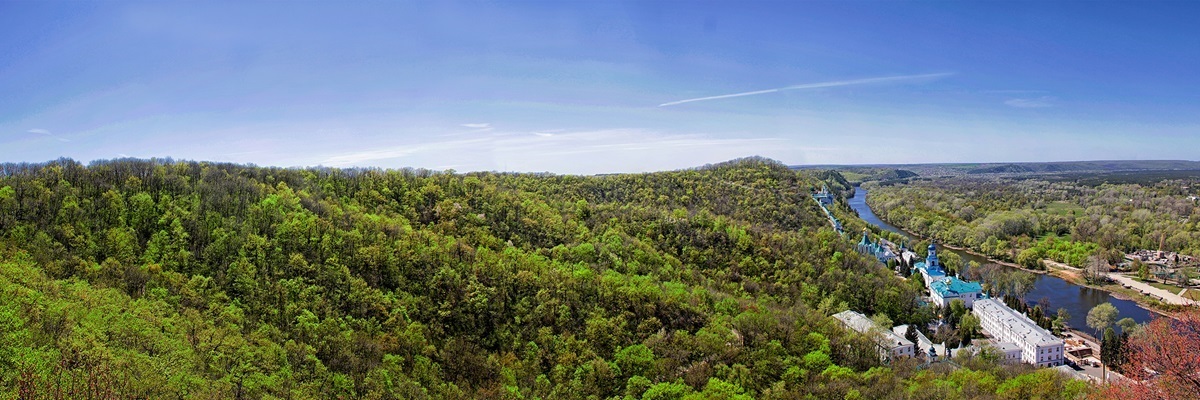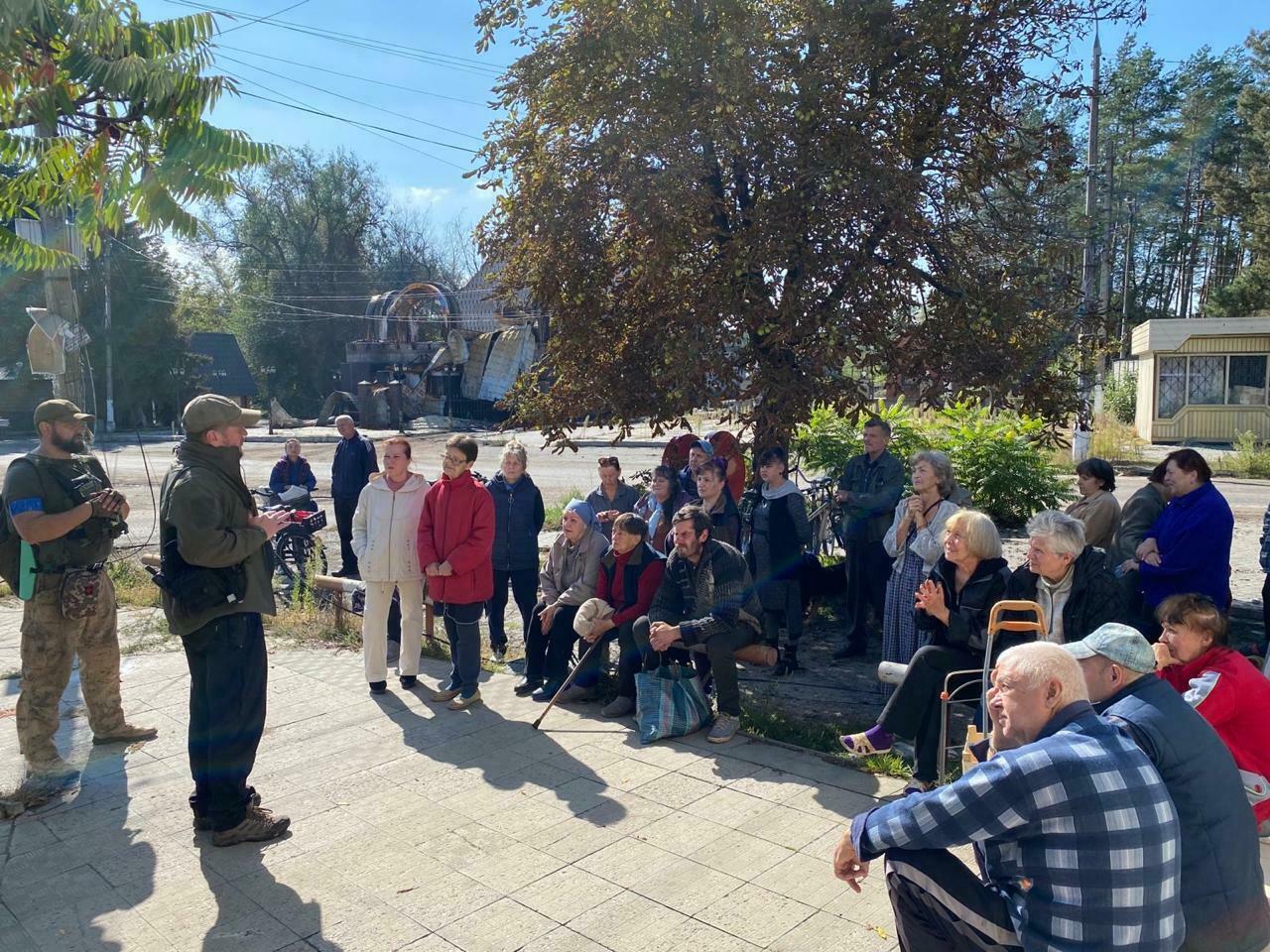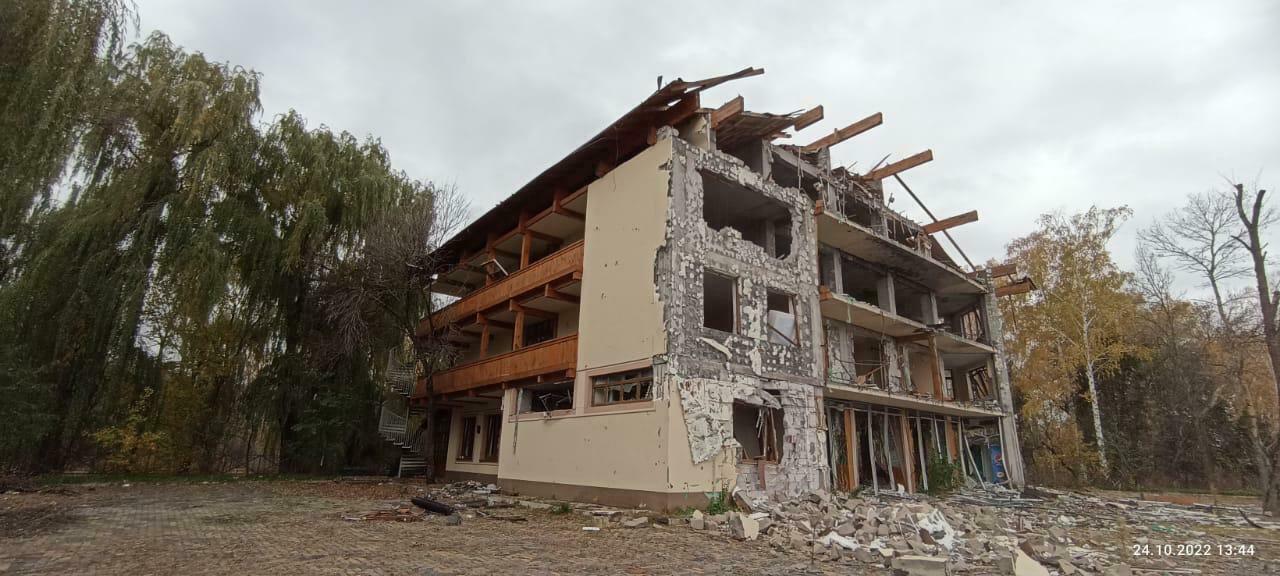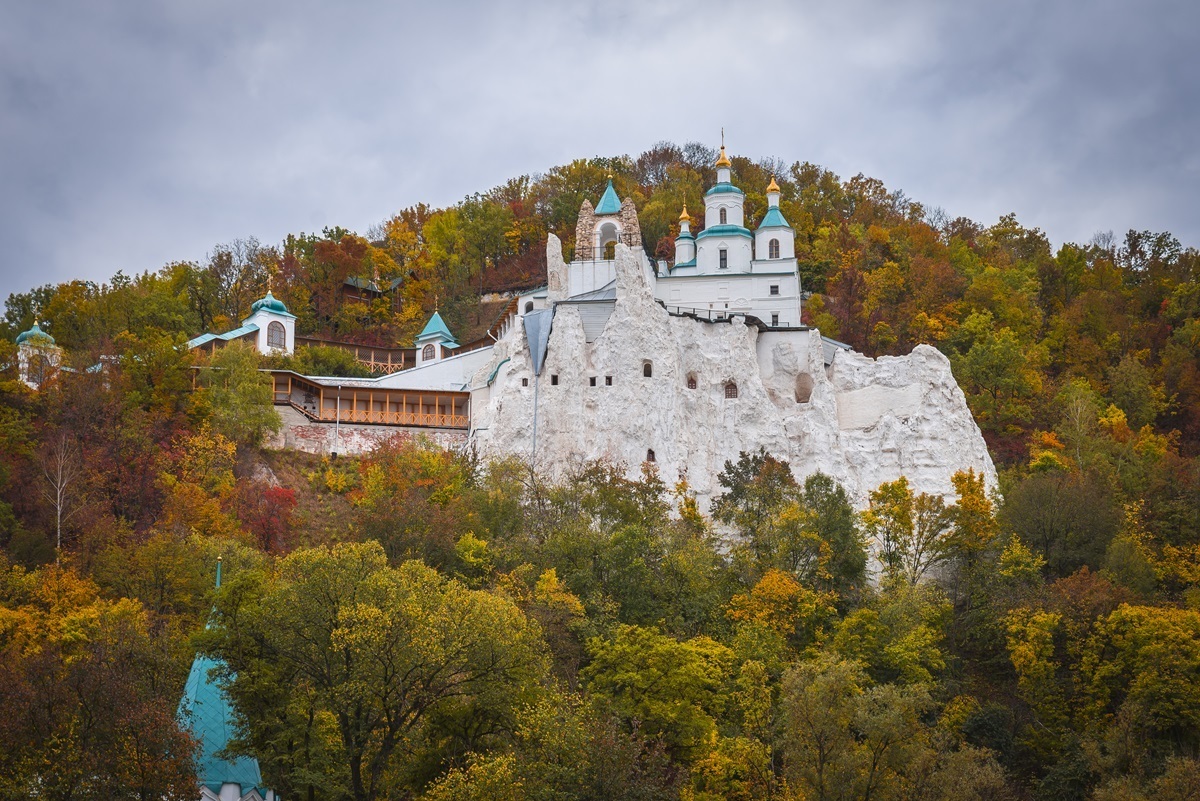Sviatohirsk is keeping strong. And so is Ukraine. The ‘Shoulder-to-Shoulder’ project in action
Volodymyr Rybalkin, Head of Sviatohirsk Military Administration of the Donetsk region, on his experience in the ATO, the peculiarities of farming near the front line and the defence of the ‘most beautiful city in the world’
By Dmytro Syniak
‘When the full-scale invasion began, I thought about where I would like to live if the Ukrainian army failed to defend Sviatohirsk, and I never found an answer to this question,’ admits Volodymyr Rybalkin, Head of the Sviatohirsk Military Administration. ‘Nowhere else in Ukraine is there such beauty, convenience, compactness, and colour... The Siverskyi Donets River in our area is calm, wide, and beautiful, as if it were a picture. White chalk mountains rise on its left bank, and they are always clearly visible from the right bank, where the city is located. There are five lakes, an oak grove, and a national nature park with huge pine trees within its boundaries. And all of this is close by, all close. Have you not been here? Be sure to come and have a look! There is a direct train from Kyiv to Sloviansk, and then another thirty kilometres by bus – and you are there...’
The interview with Volodymyr Rybalkin was postponed due to the attack on the city by the Russians with several S-300 anti-aircraft missiles. These missiles are extremely inaccurate when used against ground targets. However, if the intention is to terrorise the civilian population, accuracy is irrelevant; hitting the centre of a residential area is sufficient. The missile will hit somewhere. This is how Russian artillery operates.
Volodymyr Rybalkin, Head of the Sviatohirsk Military Administration
View of Sviatohirsk from the Sviatohirsk Lavra
‘There is no other city like Sviatohirsk in the whole world...’ Holy Mountains – a national nature park near the city
Investigative journalist, public figure, ATO veteran
Volodymyr Rybalkin was born in the now-occupied city of Makiivka, but his parents later moved to Sviatohirsk, where he grew up, finished school, completed his education, and worked for 16 years at the Smarahdove Misto (‘Emerald City’) Children’s Rehabilitation Centre. Everything changed in 2014: after Russia’s invasion, Volodymyr was called up for the fifth wave of mobilisation and spent a year and a half fighting as a rifleman in the Ukrainian Armed Forces.
‘Serving in the army changed my sense of reality,’ says Volodymyr Rybalkin. ‘I no longer returned to the ‘Emerald City’, but became a social activist. I felt that I had to make a difference. I headed a branch of the All-Ukrainian public organisation ‘Stop Corruption!’, took journalism courses, and obtained a certificate as an investigative journalist. I also later joined the board of the Donetsk Regional State Administration and its public council.’
Local businessmen and corrupt politicians were outraged by Volodymyr’s investigations, the results of which were broadcast on Channel 5, among others. The very titles of Rybalkin’s TV episodes, such as ‘Black loggers’ and ‘Sviatohirsk hypocrite’, made them nervous. Volodymyr was repeatedly threatened, and his colleagues were attacked. And yet he always won. One of his greatest victories was the resignation of Oleksandr Dziuba, the then Head of the Sviatohirsk City Council, who had been in charge of the city for 27 years. After that, the former mayor came to the ‘Stop Corruption!’ head office and promised to support civic activists in their struggle.
Some of the anti-corruption programmes created by Volodymyr Rybalkin
On cyber-attacks and threats from the local mafia to Volodymyr Rybalkin
Then the full-scale war broke out… As an experienced military man, Mr Rybalkin headed the voluntary military formation of the Sviatohirsk community, which helped the Armed Forces of Ukraine repel Russian attacks for three months. However, on 5 June 2022, Ukrainian troops were forced to retreat from the city. The then mayor, Volodymyr Bandura, who was already facing criminal charges and allegations of corruption, immediately sided with the occupiers and accused the Armed Forces of war crimes. It was then that Volodymyr Zelenskyy appointed Mr Rybalkin as the head of the Sviatohirsk Military Administration.
‘I do not see myself as a representative of local self-government. I am an administrator,’ says Volodymyr. ‘I was not elected by the people. I do not communicate with councillors or seek compromises with anyone. However, administrators like me are exactly what is needed on the front line. Now, the most important thing for the state is defence capability. Therefore, the head of a community should primarily have knowledge of building shelters and various military facilities, rather than, for example, planting flowers. About two-thirds of the head of the military administration’s work is spent interacting with various military units.’
At first, of course, his lack of experience was evident and he found it extremely difficult. However, Volodymyr Rybalkin now says that he can teach others.
‘The head of the military administration is responsible for many more things than a peacetime mayor,’ he says. ‘In addition to evacuating people, building bomb shelters and helping the military, the head has to ensure fire safety so that an accidental shell or downed drone does not burn down entire neighbourhoods, forests, or fields. They have to ensure there are fire ditches and defence lines everywhere. Under the leadership of the head of the military administration, the community should become a real fortress.’
Volodymyr Rybalkin’s first meeting with residents of Sviatohirsk after de-occupation in September 2022
Volodymyr Rybalkin (in the centre) at a working meeting in the Donetsk Regional Military Administration
Four villages of the community were left in ruins, 48 local residents were killed
When Sviatohirsk and two other occupied villages were liberated from the Russian invaders on 12 September 2022 during the Slobozhanske counter-offensive of the Ukrainian Armed Forces, Volodymyr Rybalkin observed a sad scene. Everything in these villages had been destroyed, there was no electricity, no water, no communication. Animals left to fend for themselves roamed the streets. Volodymyr began to restore normal life, step by step.
There was no money for this because the two sectors that had previously filled the Sviatohirsk community’s budget — tourism and agriculture — were in a deplorable state. Farmers were unable to work because the community’s fields were littered with explosive devices. Almost all of the 57 recreation centres, which could accommodate around 15,000 holidaymakers at a time prior to the war, had been destroyed and looted. The Russians took not only chainsaws and grinders, but also scythes and hammers. They took everything that could be taken away…
Meanwhile, the community’s expenses increased because it had to support the military, who did not pay for any of the resources they used. The community never refused them anything.
However, while it was possible to find funding to replace windows and roofs, major reconstruction seemed almost impossible. A symbol of Russian aggression in Sviatohirsk was a five-storey building on Ivan Mazepa street that was hit by an S-300 missile when the occupiers retreated. The Sviatohirsk Military Administration prepared a restoration project and all the necessary documentation. However, they failed to secure funding for the reconstruction, as international donors were deterred by the proximity and volatility of the front line, which is now only 20 km from Sviatohirsk. So, the building remained in ruins.
‘I am most proud of what my team has managed to do in the three de-occupied localities,’ admits Volodymyr. ‘Together with international organisations, we have repaired about a thousand private houses, organised the evacuation of those who agreed to leave, and resumed the provision of services and humanitarian aid to those who stayed. Now we have an Administrative Service Centre, as well as branches of a bank, Nova Poshta, Ukrposhta... And all of this is functioning quite well, despite the proximity of the frontline.’
The most challenging task was exhuming the dead. The military administration had to rebury 48 local residents who had been killed by the occupiers or died from shelling, landmines or a lack of medical care. The four villages located along the banks of the Siverskyi Donets River suffered the most. The enemy, advancing from Izium in an attempt to reach Sloviansk, was unable to cross the river.
The large village of Bohorodychne, located on the right bank of the Siverskyi Donets River, was passed through several times. However, the Russians were unable to gain a foothold in the village and eventually retreated across the river. Realising that they would not be able to cross the river, the enemy began systematically burning the houses in the village to the ground. As a result, Bohorodychne and the surrounding villages of Mazanivka, Krasnopillia and Dolyna were left in ruins.
Volodymyr Rybalkin realised that people needed new housing as soon as possible, so he quickly organised the collection of all the necessary documents. As a result, residents of the Sviatohirsk community have already received housing certificates worth more than UAH 1 billion under the government’s eRecovery programme.
‘When we returned after the Russians had fled, only about 550 people remained in the entire community, down from 9,000,’ recalls Volodymyr Rybalkin. ‘I am proud that relatively few left with the Russians — only around 200 of our residents. A third of those who left for territory controlled by the Ukrainian government later returned home. Believe me when I say there is no other place like Sviatohirsk in the world…’
A five-storey building on Ivan Mazepa street destroyed by an S-300 missile, which became a symbol of Russian aggression in Sviatohirsk
Destroyed Cultural Centre in the village of Khrestyshche
Aftermath of the explosion of an MLRS missile in the village of Khrestyshche, which struck the asphalt and exploded underground
A hotel in Sviatohirsk. Most of the community’s tourist infrastructure now looks like this
Volodymyr Rybalkin handing out humanitarian aid in the village of Sydorove
An elderly resident of the Sviatohirsk community returns home after receiving her pension at the mobile Ukrposhta office. Photo from 2023
How the ‘Shoulder-to-Shoulder’ project is saving Sviatohirsk
The loss of two-thirds of the residents has led to serious staffing shortages. According to Volodymyr Rybalkin, ‘Neither land managers, architects nor representatives of many other professions want to work in close proximity to the front line.’ Consequently, areas in which these specialists are involved are lagging behind. To solve this problem, the head of the Sviatohirsk Military Administration is relying heavily on partners, particularly the ‘Shoulder-to-Shoulder: Cohesive Communities’ project. As part of this project, the Sviatohirsk community has signed two memoranda of cooperation, one with the Velykyi Bereznyi community in the Ternopil region, and one with the Chemerivtsi community in the Khmelnytskyi region.
‘We are in constant contact with the heads of these communities, and they are very supportive and helpful,’ says Volodymyr Rybalkin. ‘We discuss solutions to many problems, including the staffing issue. I think that specialists from partner communities will soon be helping us, either remotely or while visiting us on business trips.’
The Sviatohirsk community is working on three areas as part of the ‘Shoulder-to-Shoulder’ project. The first is the construction of bomb shelters in the basements of multi-storey buildings, which have now been converted for this purpose. The Velykyi Bereznyi community has allocated UAH 700,000 for this purpose, while the Chemerivtsi community has allocated UAH 500,000. The second area is cultural cooperation and children’s recreation. Children from Sviatohirsk recently spent a week in the Ternopil region, and they are planning to visit the Khmelnytskyi region in the future. The third area is humanitarian cooperation. This primarily involves providing the Sviatohirsk community’s social laundries with everything they need. These are special sanitary modules where people without access to a centralised water supply can wash their clothes for free.
Another area of cooperation is the centralised evacuation of local residents. Sviatohirsk residents tend to stick together, so small communities have formed in Kyiv, the Cherkasy region, Zakarpattia and the Netherlands. Volodymyr Rybalkin is already in talks with partners of the ‘Shoulder-to-Shoulder’ project about resettling Sviatohirsk community residents ‘not just anywhere, but with their people’, if necessary.
‘The war has divided Ukrainian communities into occupied and unoccupied, frontline and rear. There are those who are living the war, and those who are only watching it on TV,’ says Volodymyr Rybalkin. ‘In these circumstances, the ‘Shoulder-to-Shoulder’ project is extremely important. It enables representatives of communities that have not been affected by the fighting to witness the consequences of the war first-hand. For example, in the Dolyna starosta district, which includes the four destroyed villages I mentioned, there is still no electricity, and it is unlikely to be restored soon. This would require a lot of money. Forty people still live there. It is worth seeing how they have managed to live there for three years without electricity…’
Working meeting with the head of the Donetsk Regional Military Administration in Kramatorsk this February. In the centre, from left: Volodymyr Rybalkin, Head of the Sviatohirsk Military Administration, with Andrii Halaiko, Head of the Velykyi Bereznyi community, and Mariana Tomyn, Head of the ‘Shoulder-to-Shoulder: Cohesive Communities’ national project
Sviatohirsk has signed 55 memoranda of cooperation in three years
The Sviatohirsk community is not the only one to have partners in the ‘Shoulder-to-Shoulder’ project. Over the past three years of full-scale war, it has signed 55 memoranda of cooperation with various international organisations. Notably, two of these are sister cities from the United States: Easton and Ashtan. Volodymyr Rybalkin assures us that ‘it was not too difficult, because since 2022, the attention of many international organisations has been focused on the Donetsk region.’ Many famous people have visited Sviatohirsk, including the renowned American philanthropist Howard Buffett.
Volodymyr Rybalkin is particularly proud of his fleet of municipal vehicles, which were exclusively donated by international organisations and American sister cities. Prior to the full-scale war, the Sviatohirsk community only had a lift truck and a garbage truck, both of which were later seized by the Russians. The military administration now has four 20-tonne dump trucks, a crane, a modern refuse collection vehicle, two minibuses, three backhoe loaders, a 13-cubic-metre vacuum cleaner and a snow plough. There are so many vehicles that the Sviatohirsk Military Administration lends them to other communities. To protect this valuable property from enemy drones, each vehicle is equipped with a separate storage facility.
However, while vehicles can still be purchased, this is not the case with specialists. Excavator operators and truck drivers are now worth their weight in gold.
‘Every frontline community is chasing after such specialists. If you have them, you literally pray for them,’ says Volodymyr Rybalkin. ‘You visit everyone personally every day, asking if they are doing well. The specialists appreciate this attention. They see that you are here and have not run away, and this encourages them to stay...’
For the first year and a half after the de-occupation, the Sviatohirsk community had no family doctor. Once again, international organisations offered their help: Médecins Sans Frontières, Médecins du Monde, FRIDA.UA and others. Later, one of the doctors returned to the community.
Teachers in Sviatohirsk still continue to work with children online, but from 1 September this year, online learning will finally come to an end, in accordance with the government’s order. Out of the community’s five schools, only one remained intact. However, Volodymyr Rybalkin is determined to restore a second school and open two educational institutions in order to retain their teaching staff.
The head of the military administration is being very cautious with his comments about the Sviatohirsk Lavra. It is still under the Moscow Patriarchate and, during services, its priests commemorate Patriarch Kirill Gundyayev, who blessed the Russian military to kill Ukrainians. Nevertheless, Volodymyr does not consider the monks to be pro-Russian or harmful to Ukrainian statehood.
‘The Lavra, located on the left bank of the Siverskyi Donets River, was not occupied,’ says Volodymyr Rybalkin. ‘Despite the shelling that damaged several of the church’s columns, they were waiting for the ‘Russian world’. When the Russians were retreating, around 150 people hiding in the monastery from the shelling built a raft and swam to the ‘Russian’ side. Since then, there has been no information about any anti-Ukrainian activities by the residents of the Sviatohirsk Lavra. It is now carrying out a humanitarian mission, sheltering, and feeding homeless people. It is very difficult to transmit information to the Russians from the Lavra because there is no internet or mobile phone connection within a 30 km radius. The only exception is Starlinks, but these are under the full control of the military administration. The Lavra is Ukrainian cultural heritage and part of the Ukrainian state reserve, leased by the monastery. It should be treated as such.’
St. Nicholas Church of the Sviatohirsk Lavra on a chalk cliff. The enemy never reached this place. Monks help refugees, but still pray for the health of Kirill Gundyayev, Patriarch of Moscow, who blessed Russian soldiers to kill Ukrainians
The Sviatohirsk Secondary School (grades 1-3) looks like this. During the occupation of the city, Russian tank crews fired at the school with tank guns for fun
A team from the Red Cross Rapid Response helped the Sviatohirsk community solve its most pressing problems in 2022
Distribution of food kits from World Central Kitchen in Sviatohirsk immediately after de-occupation. For 2.5 years, this international organisation prepared and distributed free hot meals and food kits to residents of the Sviatohirsk community
In early 2023, renowned American philanthropist Howard Buffett delivered several truckloads of food parcels to Sviatohirsk
The pig that caused the man to refuse to evacuate ended up almost eating him later
Cultural treasures owned by the state, including items from the Lavra and community museums, were moved to safer locations a long time ago. Volodymyr Rybalkin is now concerned with preparing people for a potential evacuation should the front line move too close. However, this is not a simple task.
‘The head of the military administration complains that people who have survived the occupation are no longer afraid of it. However, the way the war is being fought now is different from how it was fought in 2022. Now, if the enemy captures a city or village, they will usually only find ruins — the fighting is so intense. However, people still do not recognise the danger. They do not believe that it may be too late afterwards!’
Volodymyr Rybalkin sometimes finds that telling people horrific stories he witnessed in 2022 helps convince them to prepare for evacuation.
‘You go to a man and literally beg him to leave. He refuses outright, and when you visit him a week later, you find his corpse in the middle of the yard, half-eaten by dogs. Another man says he is not going anywhere because he does not want to abandon the pig he has been feeding for years. Later, we only just manage to save him from the pig, which is starving and already sees its injured and weak owner as food. Here you are, asking your parents to leave and save themselves and their children. They assure you that they have a secure cellar. Yet here you are, digging up the cellar and removing their bodies one by one... There were many such episodes during my time in service. Some people start to pay attention to my words when I tell them about these episodes. However, many people still live in denial: they claim that if drones only fly over our heads and do not drop bombs, it means that the Russians are not interested in us…’
‘I am very sorry that Ukrainians know so little about Sviatohirsk and what is happening here,’ says Volodymyr Rybalkin as he leaves. ‘If they knew more, they would probably help us more actively. This support is crucial for the entire country. After all, it is here in the Donetsk region that the Armed Forces of Ukraine defeat the enemy every day. However, to counteract this more effectively, frontline communities and outposts must be strengthened, as set out in the ‘Shoulder-to-Shoulder’ project. This should be understood by everyone in Ukraine, from Kharkiv to Uzhhorod.’
The evacuation of the Sviatohirsk elderly care home, which survived the occupation, went like this
The only way to transport the elderly to the territory controlled by the Ukrainian government was by boat. All the bridges across the Siverskyi Donets River had been blown up
A mother and her children from the village of Tetianivka rescued by the Sviatohirsk military administration. The family members flatly refused to evacuate until they lost a close relative due to shelling and were wounded themselves.
Seven things you might not know about Sviatohirsk and its history
- The first written reference to the ‘settlement and river crossing near the Holy Mountains’ dates back to 1526. This was recorded by the Austrian diplomat, scientist and traveller Sigismund von Herberstein.
- The first written record of the Sviatohirsk Assumption Monastery dates back to 1624. It was located on the right bank of the Siverskyi Donets River, amidst the chalk cliffs. A settlement called Banna grew up around it, named after the bathhouses that also served the monks. The present-day city of Sviatohirsk developed from this settlement.
- In 1787, Catherine II literally raided the monastery, closing it by her decree and subsequently transferring its land and property to her lover, Hryhorii Potiomkin. Potiomkin’s descendants revived the monastery only 57 years later.
- During the Soviet era, the Sviatohirsk Monastery was closed again and its buildings were converted into a recreation centre. The main Assumption Cathedral was even turned into a cinema. The monastery was only restored in 1992, after Ukraine gained independence.
- Although Sviatohirsk has always been a small town, it had a horse-drawn tram until 1941 that took passengers from the railway station to the banks of the Siverskyi Donets River. The journey covered a distance of about 6 km.
- Sviatohirsk is the northernmost city in the Donetsk region, forming part of the Kramatorsk agglomeration. It is located at the intersection of three regions: Donetsk, Kharkiv, and Luhansk.
- Sviatohirsk is the greenest city in Ukraine. In 2004, each resident had access to 144.2 square metres of green space, the highest figure in the country at the time. The international standard is at least 20 square metres.
Sviatohirsk Lavra as seen from above
All photos for this article were provided by the Sviatohirsk Military Administration or taken from open sources

Tags:
war stories special project report side by side war stories
Область:
Донецька областьГромади:
Святогірська територіальна громадаSource:
Decentralization portal

24 June 2025
Оновлені правила використання коштів субвенції на «Нову українську школу» - інфографіка
Оновлені правила використання коштів субвенції...
Експерти Швейцарсько-українського проєкту DECIDE підготували інфографіку про оновлені правила використання коштів...
24 June 2025
Рішення на основі даних: Тернопільщина презентувала геоінформаційну систему області
Рішення на основі даних: Тернопільщина...
У Тернопільській області офіційно презентували Геоінформаційну систему області (ГІС) — масштабний цифровий...
24 June 2025
Реформа управління публічними інвестиціями: розпочалися регіональні презентації
Реформа управління публічними інвестиціями:...
Міністерство розвитку громад та територій України у партнерстві з міністерствами економіки та фінансів організовує...
24 June 2025
Ще 50 центрів життєстійкості відкрилися в Україні
Ще 50 центрів життєстійкості відкрилися в Україні
Упродовж червня Міністерство соціальної політики разом із громадами та у співпраці з громадськими організаціями...




















